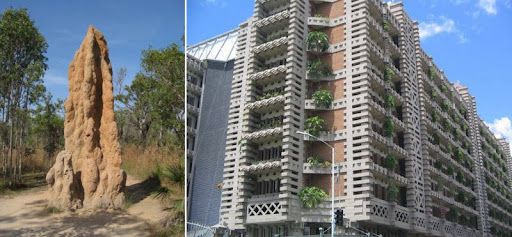Tiny But Mighty: How Termites are Paving the Way for Eco-Friendly Buildings

A termite mound side by side with the Eastgate building.
Hidden behind plaster, termites carve their paths, infesting foundations and tearing down supports one bite at a time. To most, these pests are nothing but a nuisance, an unlucky circumstance that takes thousands of dollars to fix. To Mick Pearce, however, these small insects provide inspiration and answer the question: how can humanity utilize nature to build energy-efficient and sustainable buildings?
Mound-building termites, mainly found in Africa, Australia, and South America, masterfully construct their mounds using clay, dirt, and at times, their saliva and feces. These efficient homes provide natural ventilation and transportation paths, all while housing millions of termites. The architects of the natural world make sure to inhabit efficient and sustainable quarters. Heated by the sun during the day, their mounds self-regulate the interior temperature–the adjustable air vents paired with the natural day and night cycle allow the termites to remain at a constant, comfortable temperature, never too hot nor too cold.
While these mounds may be a fascinating subject of study on their own, we can learn a lot from their design. Mick Pearce, an architect from Zimbabwe, found these termite mounds to be the solution for an energy-efficient and sustainable building. Inspired by the chimney-like shape of termite mounds, Pearce designed the Eastgate building (https://www.mickpearce.com/Eastgate.html) in Harare, Zimbabwe. Using a technique similar to that of the termites, Pearce designed Eastgate to pull warm air upwards through brick chimneys on the roof. These chimneys create a cycle, releasing warm day air through the top of the chimneys while harnessing cold evening air from the bottom. Fans on the first floor circulate the cool air throughout the building, maintaining a stable and comfortable temperature during the hot summer months. By creating an entirely self-regulating building, there is no need for air conditioning.
The Eastgate building is an astounding example of biomimicry and human ingenuity in sustainable architecture. Biomimicry is defined as the imitation of nature to solve humanity’s complex challenges. Through the use of high-resolution scanning, CT scans, and other computer simulations, researchers examined the exact structure of these mounds to determine what elements could be used to improve climate control. Once these features were identified, they were adapted to solve a human conundrum. While designing buildings that look like termite mounds may not become the next architectural trend, adapting nature’s wisdom to regulate temperature may be a step forward in designing sustainable buildings.
To create eco-efficient buildings to house Earth’s ever-growing population, architects must turn to the force that has already figured it all out: nature. By borrowing what already exists, and has worked for thousands of years, we are able to better understand the world around us–an understanding that is essential if we are to preserve our natural resources and environment. Despite their status as pests, termites may be the key to designing a better future, one bite at a time.
